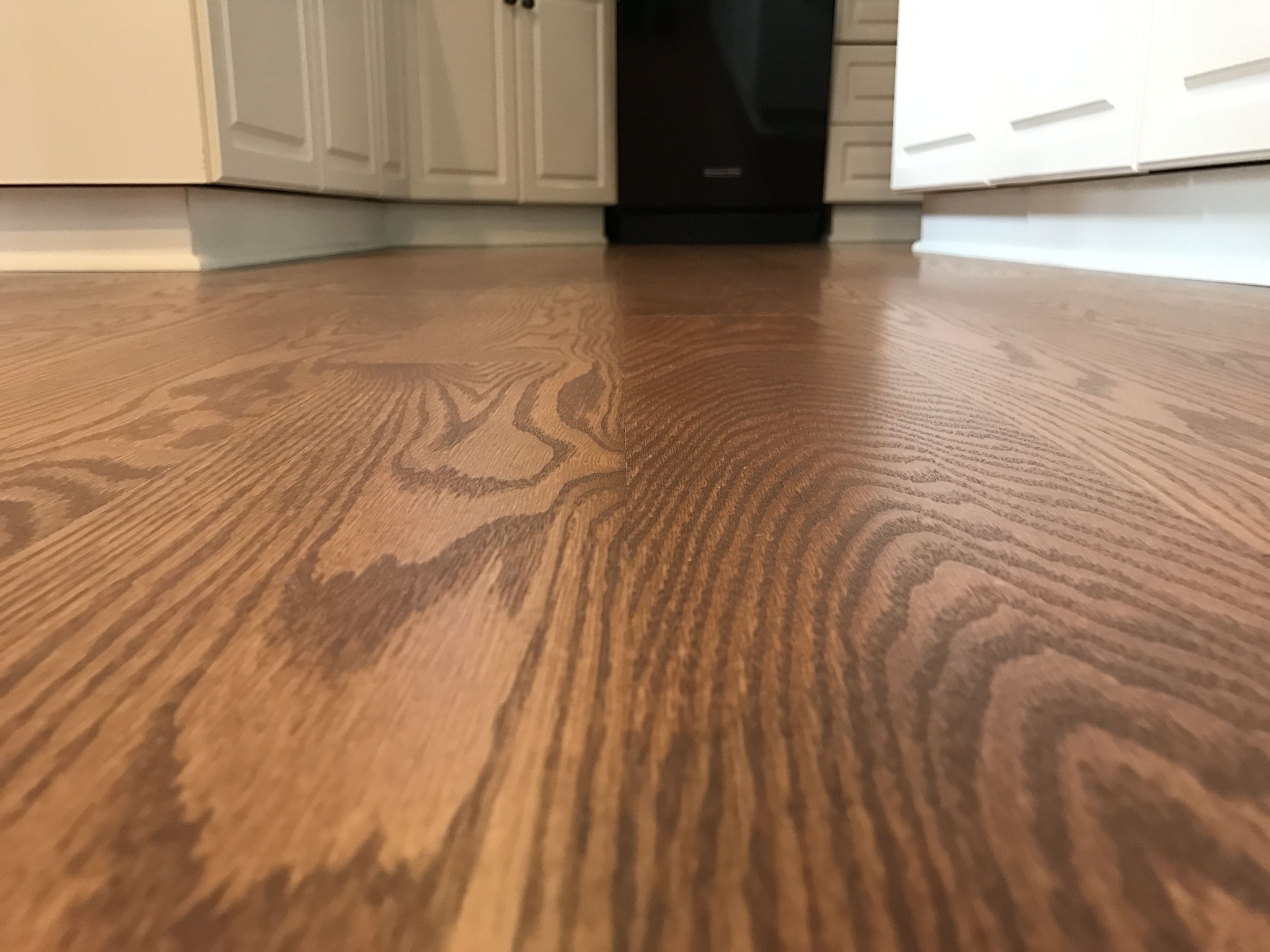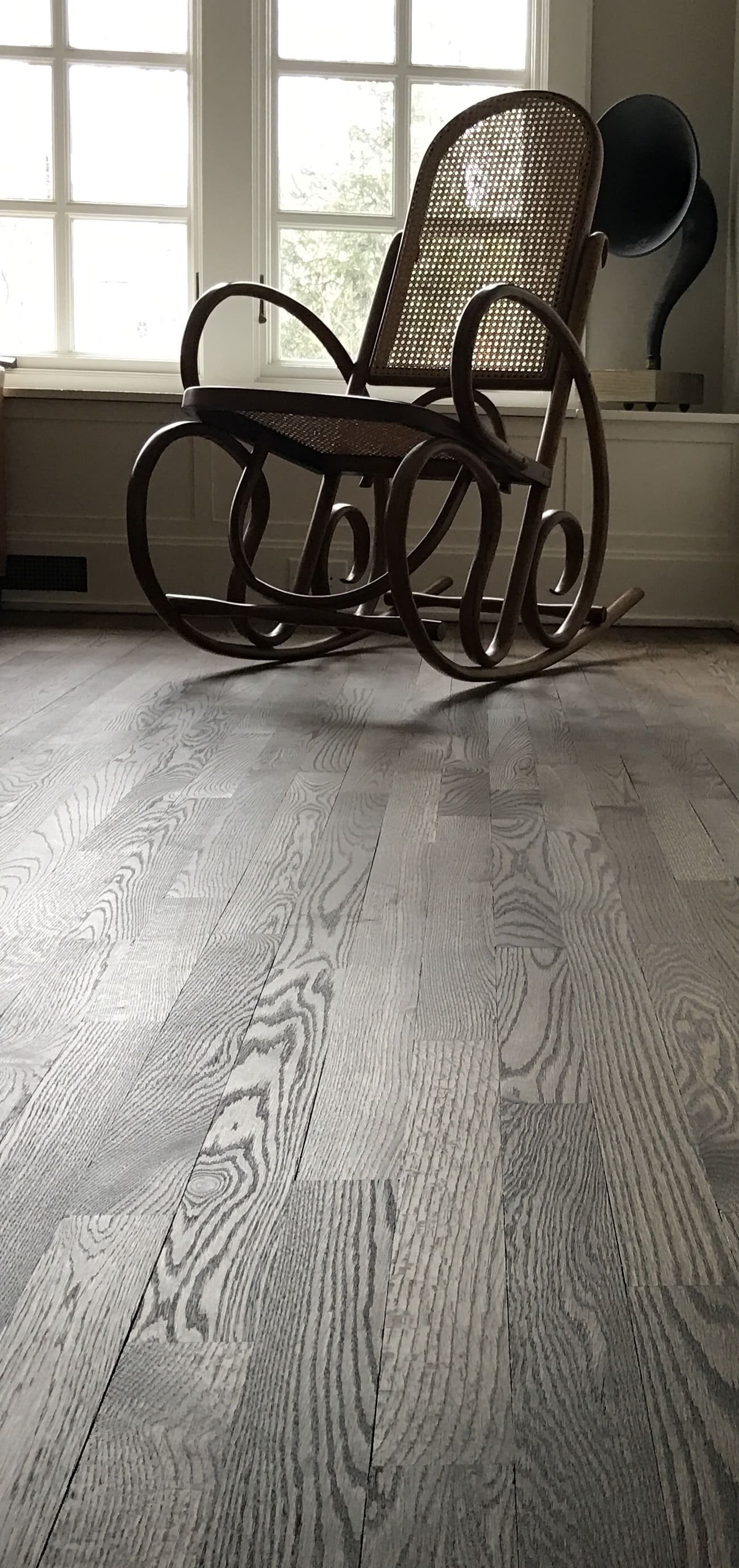Rubio Monocoat vs Standard Floor Finish: What are the Differences?
Hello everyone, Patrick here! I'm excited to bring you a special update today. I've been revisiting and refreshing all my old Rubio Monocoat blog posts, starting with the most popular one. This post had some information that needed a bit of updating, so here's the newly revamped version for 2024! As we embrace the holiday season and look forward to the new year, I wish you all joy and happiness. Now let’s dive into this updated blog post together and discover the latest insights on these wood floor finishes!
Picture this: a beautifully crafted wooden floor under your feet, its texture smooth and inviting. Now, think about the vital layer that sits atop it - the finish that defends the wood from the hustle and bustle of everyday life. This protective coating is more than just a shield against scratches and spills; it's an element of artistry that elevates the look and feel of your space. In today's post, we'll delve into a comparison between two renowned wood finishes – Rubio Monocoat and the standard oil/water-based finish. Join me in exploring these two options to determine the best choice for your hardwood flooring needs.
Freshly finished White Oak floors, rift and quartersawn. Finished with Rubio Monocoat Fume + Colored 2c oil
Key Takeaways
Rubio Monocoat & Standard Floor Finishes provide different levels of protection, durability, aesthetic appeal, and environmental impact.
The application process for each type of finish varies significantly, with Rubio Monocoat being tougher to apply but visually more appealing.
When selecting a wood floor finish, consider your needs and preferences as well as the scope of the project before making a decision on which is best suited for you.
Understanding Rubio Monocoat & Standard Flooring Finishes
Rubio Monocoat Hardwax Oil and standard oil-based/water-based finishes are at opposite ends of the spectrum when it comes to wood finishes. Whether it be for floors or for furniture, both tackle the same issue, protecting your wood. Rubio Monocoat, a single-coat, eco-friendly wood finish, enhances the wood’s natural beauty while offering long-lasting protection.
Standard wood floor finishes, on the other hand, require multiple coats of application. The application process itself, however, is much easier and quicker. These finishes are often favored for their hard, protective surface as well as cheaper cost & quicker application time.
What Is Rubio Monocoat?
Rubio Monocoat’s unique blend of natural oils and waxes offers the following benefits:
Molecularly bonds with the wood fibers, yielding a durable finish
Eco-friendly
Penetrates the wood, protecting it from within and not from the top
Highlights the wood’s unique features with endless variety of color options
The single-coat application process, a distinct feature of Rubio Monocoat, saves time and yields a natural, smooth texture and matte sheen that appeals to both sight and touch. Many rave about the single coat application step, and it is what initially convinced me to start applying this product back in 2016. However, this single coat application process is not just all rainbows and butterflies. It requires a TON of more manual labor to actually apply that singular coat. The way it looks afterwards though, absolutely stunning.
What Is A Standard Hardwood Floor Finish?
A traditional staple in wood finishing, standard oil-based and water-based finishes, are known for their hard, protective surface and high durability. These finishes permeate the wood fibers, fortifying them and furnishing a resilient protective coating. The main differences between these finishes versus Rubio, is simply the look.
Application process is also different for these finishes. Both water & oil based finishes are applied using a roller. There is a variety of other techniques that can be used, like troweling or t-baring the finish, but rolling is by far the most popular method. The finish layers are built on top of the wood floors, creating a strong protective barrier that will help against scratches and spills.
Comparing Application Process
While the end goal of both Rubio Monocoat and standard finishes is to protect and enhance the wood, their application processes differ significantly. This can be a deciding factor when choosing between the two, as the amount of time, effort, and tools required can greatly affect the overall project.
Application Of Rubio Monocoat
Michael applying Rubio Monocoat with a trowel
Rubio Monocoat application involves the following steps & a buffer IS required:
Surface preparation
Monocoat application
Fifteen-minute penetration
Excess removal
Seven-day curing period
For the application process, the Rubio must first be troweled into the wood by hand the entire time. Next, the finish must be allowed some time to sit, and penetrate into the wood. After, you can begin the removal process. This involves going over all of the flooring in a series a 3 steps after the initial application. Once with a red pad to buff more of the Rubio into the wood grain and knock down any raised grain. A second time with a white pad, to remove most of the excess Rubio on the floors. And then a third final time, going over the entire floors with towels and rags under your buffer to COMPLETELY remove any excess Rubio on the floors. -sidenote- I specifically linked the buffer pads so that you could see how much they cost. $30 for five buffer pads is not a mistake. You will need about 5 red pads and 5 white pads PER ROOM.
Keep in mind that all of this is happening while you are hustling your butt off to get through these 3 steps before the hardener inside of the Rubio begins to set. Once that happens, if you haven’t gotten through these steps, go ahead and just start pulling your sanding machines back out because salvaging the floors at that point is already too late. If you take too long and allow the Rubio to set too hard before removing it, this will cause the product to start gumming up and it becomes impossible to remove from the floors. And for those asking, yes, all of the edges must be completed at the same time by hand wherever the buffer does not reach. If you are doing stairs, they need to be entirely done by hand, too. For stairs and edges, I like to use these applicators. A single coat process sounds fun and like way less work, but really, in my eyes it’s just great marketing and nothing more. There is not a single thing about this finish that is easier to apply than regular finishes, unless of course all that you are going to be doing is just applying it to a tiny surface, like a table top or bookshelf.
Application Of Standard Finishes
The final coat of Loba Water-Based Finish being applied to a new floor
The application of standard finishes is much quicker and less laborious. It includes applying a couple coats of finish, lightly sanding between each whether it be by hand or with a buffer, and providing ample drying time. This process can also be labor-intensive and time-consuming, but for larger areas, it is much easier and quicker than Rubio. You can also do this by yourself, whereas with the Rubio you will at minimum need a team of 2 people to cover 1,000 square feet.
Please remember that the type of roller cover you use to actually apply your finish makes a huge difference. If you are specifically applying a water-based finish, these MUST be applied using a microfiber roller.
Aesthetic Differences
When it comes to the appearance of your wood surface, Rubio Monocoat and standard finishes offer distinct and beautiful results. The choice between the two depends on your aesthetic preferences and the look you aim to achieve.
Rubio Monocoat Appearance
Close-up of a floor in Highland Park, IL finished with Rubio Monocoat
Rubio Monocoat is celebrated for its capacity to amplify the wood’s inherent attractiveness. It’s most unique and distinct feature is the fact that it doesn’t build up a film layer on top of your floors. This means the floors will come out looking as matte as they possibly can, with very little to no sheen once fully cured. Rubio Monocoat is available in a variety of colors, all unique to Rubio, allowing for customization to suit your specific design preferences.
The outcome is a natural wood look no matter what color you choose, with a matte finish that elegantly highlights the inherent beauty of any wood that you apply it to.
Standard Finish Appearance
Brand new floors finished with Loba water-based finish. As you can see, even though they are a satin sheen, the shine level is quite different to Rubio as well as the overall appearance of the floors.
Conversely, standard finishes can modify the wood’s look, often intensifying its color and accentuating the grain differently. These finishes offer a range of sheens, from glossy to matte, which can dramatically affect the overall look of the wood. Over time, certain standard finishes can also cause the wood to darken or develop a yellowish sheen, which can add a vintage or aged look to the wood. It’s important to note, that the same will happen with Rubio Monocoat. Because it is a natural oil, it will still have the same yellowing properties over time as oil based finishes do.
Durability And Maintenance
Rubio Monocoat and standard finishes present their own unique advantages and disadvantages in terms of durability and maintenance. It’s important to consider how much maintenance you’re willing and able to do, and what kind of wear and tear the surface will be exposed to.
Rubio Monocoat Durability
Newly installed Rift & Quartersawn White Oak flooring in Downtown Chicago, IL finished with Rubio Monocoat Fume + Pure 2c oil
Rubio Monocoat is known for its excellent durability and resistance to wear and tear. Offering long-lasting protection, Rubio Monocoat can withstand heavy foot traffic and scratches. However, because it has no film layer on top, I’ve found that this finish suffers a bit more when it comes to chemical resistance & spills. The scratch protection is better than a standard finish, but the chemical and spill resistance certainly suffers.
With proper care, a wood floor finished with Rubio Monocoat can last a very long time. But, that care is much more in-depth than what most people think. For hardwood floors finished with Rubio, you must use their specific Rubio soap to clean the flooring. You can never use anything else, because their soap acts as a light re-oiling every time you clean the floor surface. It is also highly recommended to apply a fresh coat of Rubio Monocoat every 3-6 years to keep the floors looking as fresh as possible.
Standard Finish Durability
Close up of a fully finished floor with standard finish. As you can see, there is a clear film layer over the top of this wood, which creates a smooth surface that protects it from the top
Standard finishes offer strong protection for wood surfaces as well. Known for their hard surface and high durability, they form a sturdy bond with the flooring material, making them resistant to wear and tear.
Usually, the comparison I point out to clients between these two finishes that I’ve personally noticed over the years is this. I believe standard film forming finishes have better resistance to chemicals and spills. But, Rubio Monocoat is much more durable when it comes to scratch resistance. What does this mean for your home specifically? It means that if you have dogs or pets in general, probably opt for a standard finish. Sure, the Rubio Monocoat might hold up better to scratches from your dogs nails, but if your dog throws up on the floor, the standard finish will hold up whereas the Rubio will likely haze around that area if it is left too long.
Environmental Impact; Eco Friendly? Or Not?
Very old hardwood floors from 1980 finished using Rubio Monocoat Black 2c Oil
So I’m sure by now you’ve heard everyone talking about how eco friendly Rubio monocoat is. How it’s all zero VOC and incredibly safe to inhale or be around. Is it true? Years of a lot of clever marketing, I’d say.
Rubio Monocoat's Eco-Friendly Features
Rubio Monocoat’s prominent feature is its eco-friendliness. As a plant-based product, it uses natural ingredients and contains no volatile organic compounds (VOCs), which are harmful to both the environment and human health. Its rich formulation ensures a sustainable and effective solution for wood protection…or so they claim
Patrick, stop beating around the bush, is it zero VOC or not? Well, in my professional opinion, no, it isn’t. Now don’t get me wrong, if you use JUST the Rubio Monocoat 2c oil without the added hardener, then yes, it can be zero VOC. But if you are actually applying this product to floors or furniture, you need to add the 2c hardener, it isn’t optional. And guess what? That hardener is anything but zero voc. Yeah, I’m not kidding. Get a couple of rags soaked in this stuff, put them in a trash bag, and put it out on your lawn in the sunlight. I can guarantee you the garbage bag with rags from this product lights up ten times quicker then a bag filled with actual oil based stain rags. I have actually had rags from Rubio Monocoat start to smoke up almost in real-time in front of me after using the rags just ten minutes prior.
I want to conclude this section by saying that, even though it has VOC’s, I do prefer the actual smell of this product verses oil based and water based finishes. This product has a much more pleasant and natural smell, even though still unhealthy.
Standard Finish Environmental Impact
Standard finishes whether oil or water based typically contain VOCs, which are harmful to the environment and can contribute to air pollution. Additionally, the production and disposal of these finishes can also have negative effects on the environment, such as air and water pollution. Obviously, these are super minimal negative effects, but they are still negative. It’s important not to breathe this stuff in while it dries, and it’s important to be out of the home for any product that you apply to your floors.
Cost Comparison
I’m not going to spend too much time on this section. Mainly because, I think you can already assume which one is more expensive, haha. It is of course the Rubio Monocoat. The cost doesn’t even compare to be honest. Rubio Monocoat is definitely more so meant for the high-end, designer market. A liter of this stuff will set you back over $200 dollars. Keep in mind, most of the pricing you see online is for quarts and not liters. One liter of Rubio Monocoat will probably get you around 200 square feet or so.
Choosing The Right Finish For Your Project
Having covered the basics, you might be pondering, “Which finish suits my project best?” The answer to this question largely depends on your specific needs, preferences, and the type of wood you’re working with.
When To Choose Rubio Monocoat
Opt for Rubio Monocoat for a very unique, durable, and trendy option that accentuates the wood’s natural beauty. It’s particularly suitable for high-traffic areas or if you desire a more natural, matte finish. The main drawbacks being the cost and durability to chemicals as well as spills.
When To Choose Standard Finish
Select a standard finish for a more traditional look, or if you simply want something that will be fairly priced as well as easy to achieve. For Rubio Monocoat, you will need special craftsmen that know how to apply it. For a standard finish, any flooring company will be able to handle it. Standard finishes can offer a high level of protection and are ideal for projects where you want to customize the shine level of the finish.
Summary
In conclusion, both Rubio Monocoat and standard finishes offer unique benefits and have distinct features that can greatly affect the look, feel, and durability of your wood surfaces. Your choice between the two will depend on a variety of factors, including your aesthetic preferences, environmental considerations, maintenance needs, and budget. By understanding the properties and benefits of both Rubio Monocoat and standard finishes, you can make an informed decision that best suits your project needs. As always, if you have any questions feel free to reach out.
Frequently Asked Questions
What Are The Downsides Of Rubio Monocoat?
Rubio Monocoat finishes offer strong resistance to scratches, but they suffer in resistance to chemicals as well as spills. This is a downside of this product.
Is Rubio Monocoat Better Than Polyurethane?
Ultimately, it depends on your goals when choosing which flooring finish is best for you.
What Are The Advantages Of Rubio Monocoat?
Rubio Monocoat provides a durable protection for all types of hardwood floors. It only takes 1 day to apply, making it an ideal choice for flooring.
What Is The Difference Between Rubio Pure And Natural?
Rubio Monocoat Pure contains no pigment, whereas Natural has a creamy whitish/yellowish pigment, making the difference between them quite clear. Natural will give you more of a traditional amber color, whereas natural will give you a lighter and brighter color.
What Is The Primary Difference Between Rubio Monocoat And Standard Finishes?
The primary difference between Rubio Monocoat and standard finishes is that the former is a single-coat, eco-friendly wood finish while the latter requires multiple coats and may have a higher environmental impact. The application processes for the two are entirely different.









